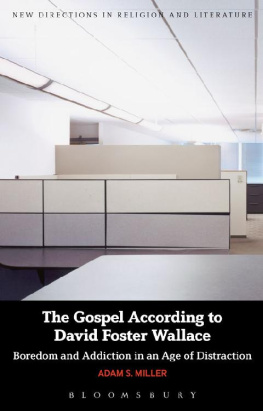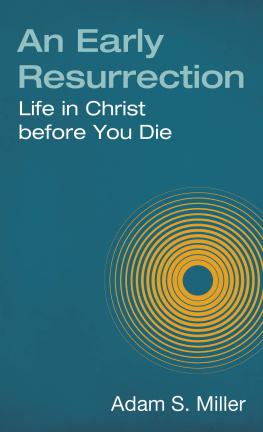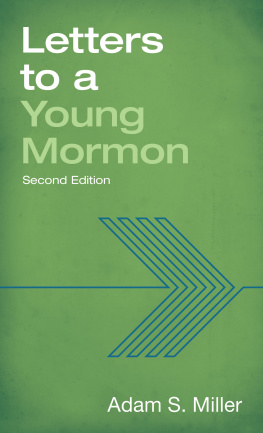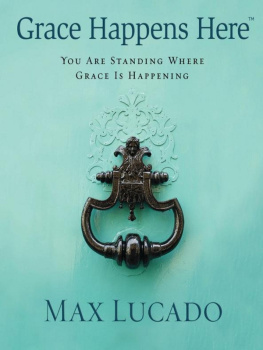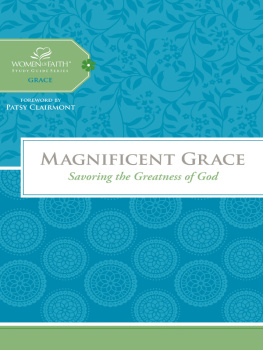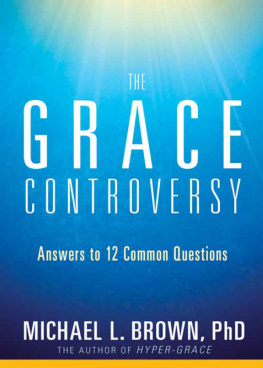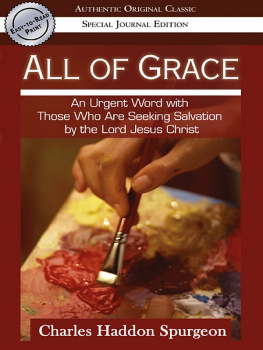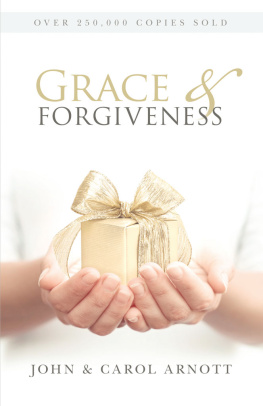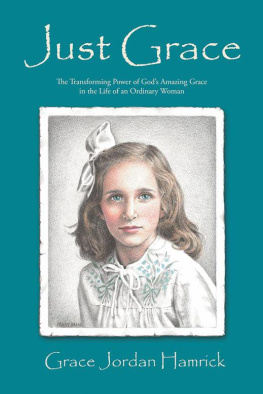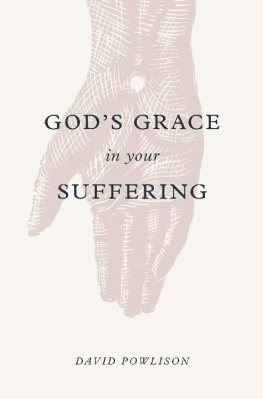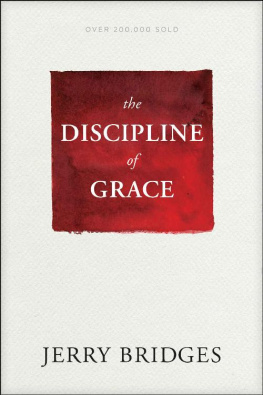Additional Praise for
Original Grace
Adjust the angle of your window blinds, even a little, and watch the sunlight stream through. Adam Millers Original Grace adjusts the angle of our shared thinking about sin, salvation, justice, and grace, and helps us re-see the atonement in the new light that fills our view. What happens if we go back to the beginningof our own stories of suffering, and of the suffering story of humanityand find a scene of original grace, not original sin? What changes if we experience Gods law as empowering, not accusatory? How many knots are loosed if justice and grace are allies, not opposites? With his trademark patient reflection on scripture, here combined with vulnerable reflection on the death of his father, Miller shows us what it means that Christ also suffered once for sins, the righteous for the unrighteous, to bring you to God (NIV, 1 Peter 3:18).
Rosalynde Welch, author of Ether: A Brief Theological Introduction
Adam Miller is one of my favorite thinkers and writers. In Original Grace , he invites readers into a theological experiment: to begin with grace instead of sin. The implications of this reordering are profound. When grasped, this book is an act of grace that will change your perceptions of justice, sin, forgiveness, creation, covenant, agency, restoration, gratitude, and more.
Anthony Sweat, author of
Repicturing the Restoration and The Holy Covenants
Like Believing Christ , this is a once-in-a-generation book.
Joseph Spencer, author of 1st Nephi: A Brief Theological Introduction
Previously Published
Letters to a Young Mormon
An Early Resurrection
2022 Adam S. Miller
All rights reserved. No part of this book may be reproduced in any form or by any means without permission in writing from the publisher, Deseret Book Company, at permissions@deseretbook.com. This work is not an official publication of The Church of Jesus Christ of Latter-day Saints. The views expressed herein are the responsibility of the author and do not necessarily represent the position of the Church or of Deseret Book Company.
Deseret Book is a registered trademark of Deseret Book Company.
Visit us at deseretbook.com
Library of Congress Cataloging-in-Publication Data
Names: Miller, Adam S., author.
Title: Original grace : an experiment in Restoration thinking / Adam S. Miller.
Description: [Salt Lake City] : Deseret Book : BYU Maxwell Institute, [2022] | Includes bibliographical references and index. | Summary: Philosopher Adam Miller discusses the difference between the concept of original sin and his understanding of the Restoration concept of original graceProvided by publisher.
Identifiers: LCCN 2021062768 | ISBN 9781639930241 (hardback) | eISBN 9781649331335 (eBook)
Subjects: LCSH: The Church of Jesus Christ of Latter-day SaintsDoctrines. | SalvationThe Church of Jesus Christ of Latter-day Saints. | SalvationMormon Church. | Mormon ChurchDoctrines. | Sin, Original. | Grace (Theology)
Classification: LCC BX8643.S25 M55 2022 | DDC 230/.9332dc23/eng/20220202
LC record available at https://lccn.loc.gov/2021062768
Printed in the United States of America
Lake Book Manufacturing, Inc., Melrose Park, IL
10 9 8 7 6 5 4 3 2 1
Cover art: Amanda Carden/Shutterstock.com
Book design Deseret Book Company
Art direction: Richard Erickson
Design: Heather G. Ward
For my father
Gary Allen Miller
19472020
Contents
PREFACE
If we start right, it is easy to go right all the time; but if we start wrong, it is a hard matter to get right.
Joseph Smith
The atonement of Christ is the most basic and fundamental doctrine of the gospel, and it is the least understood of all our revealed truths.
Bruce R. McConkie
Sometimes we think of the Restoration of the gospel as something that is complete, already behind us, Elder Dieter F. Uchtdorf taught in April 2014, but in reality, the Restoration is an ongoing process; we are living in it right now.
This book is an attempt to participate in that ongoing Restoration. Consider it an experiment in Restoration thinking.
As a tradition, it seems to me that Latter-day Saints have yet to fully develop a native, homegrown way of talking about Gods grace. We often default to traditional Christian ways of talking about grace, even when those traditions have been undercut by the deeper truths of the Restoration. While unintentional, this tendency may be especially evident when it comes to the doctrine of original sin.
My proposed experiment is this: what if, instead of implicitly affirming the logic of original sin , Latter-day Saints emphasized the deeper reality of Gods original grace ?
Throughout this experiment, readers should bear in mind that I have no authority and no commission. As a scholar, I may help start conversations, but I never finish them. This experiment sketches just one possible approach among many. Take whats useful, build something better, and leave the rest.
Whats more, readers should keep in mind that, as part of this thought experiment, I do what scholars commonly do: I disagree with other scholars. I not only contrast my suggested approach with the larger Christian tradition, I contrast it with Stephen Robinsons powerful book Believing Christ. This doesnt mean, however, that I dont dearly love them both. In my view, Believing Christ is the most important book of lay theology in the history of our tradition. Honoring its legacy requires us not only to appreciate its contributions but to carry forward its unfinished work.
Im grateful to Loyd Ericson and Greg Kofford Books for permission to draw on work I originally published in Rube Goldberg Machines and Future Mormon . Im grateful to Lisa Roper for her patience, encouragement, and discerning eye. Special thanks belongs, as well, to Laurel Christensen Day, Joseph Spencer, Rosalynde Welch, Bill Turnbull, Tom Griffith, and Spencer Fluhman.
.
.Dieter F. Uchtdorf, Are You Sleeping Through the Restoration? general conference address, April 2014, https://www.churchofjesuschrist.org/study/general-conference/2014/04/are-you-sleeping-through-the-restoration?lang=eng.
I.
SUFFERING
Which is original, sin or grace?
Last night I dreamt that my father was alive. He was still using a wheelchair, but he looked strong. He could hold his head up straight. He could make a fist. He had all his teeth. His cheeks were flush. He had flesh on his bones. Whats more, he could whisper. I was surprised to see him. I apologized for thinking he was dead. I knelt by his chair and laid my head on his breast. He cradled my head in the crook of his arm and whispered into my ear, every word distinct, and I understood every word he said. I heard everything he wanted to say.
But this was a dream. My father is not alive. As I write this, hes been dead for almost a year. My brother and I dressed him in temple robes, and our family buried him on the side of a hill in Pennsylvania, not fifty yards from a cornfield.
My father died at home. He suffered from a degenerative muscle disease. Hed used a wheelchair for years. Hed needed a feeding tube for just as long. Apart from his painfully swollen feet, the disease had pared him down to skin and bones. By the end, it was hard for him to steer his chair and even harder for him to speak. He constantly struggled to clear his throat. A little more than a year ago, he took the dog and me for a walk. I held the dogs leash. He waved to passing cars, and people waved back. He told me he couldnt bear another winter in Pennsylvania. He told me he wanted my mom to be closer to family. He told me he wanted to buy a house in Texas down the street from mine. Was I planning to go anywhere? I stopped and stared down the length of that road. No, I told him. Im not going anywhere. So late last summer, after seventy years in Pennsylvania, my parents came to Texas. And while the disease continued to whittle him down throughout that winter and spring, he was recognizably himself.


